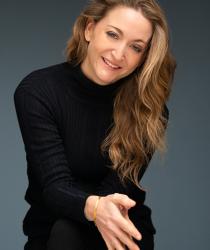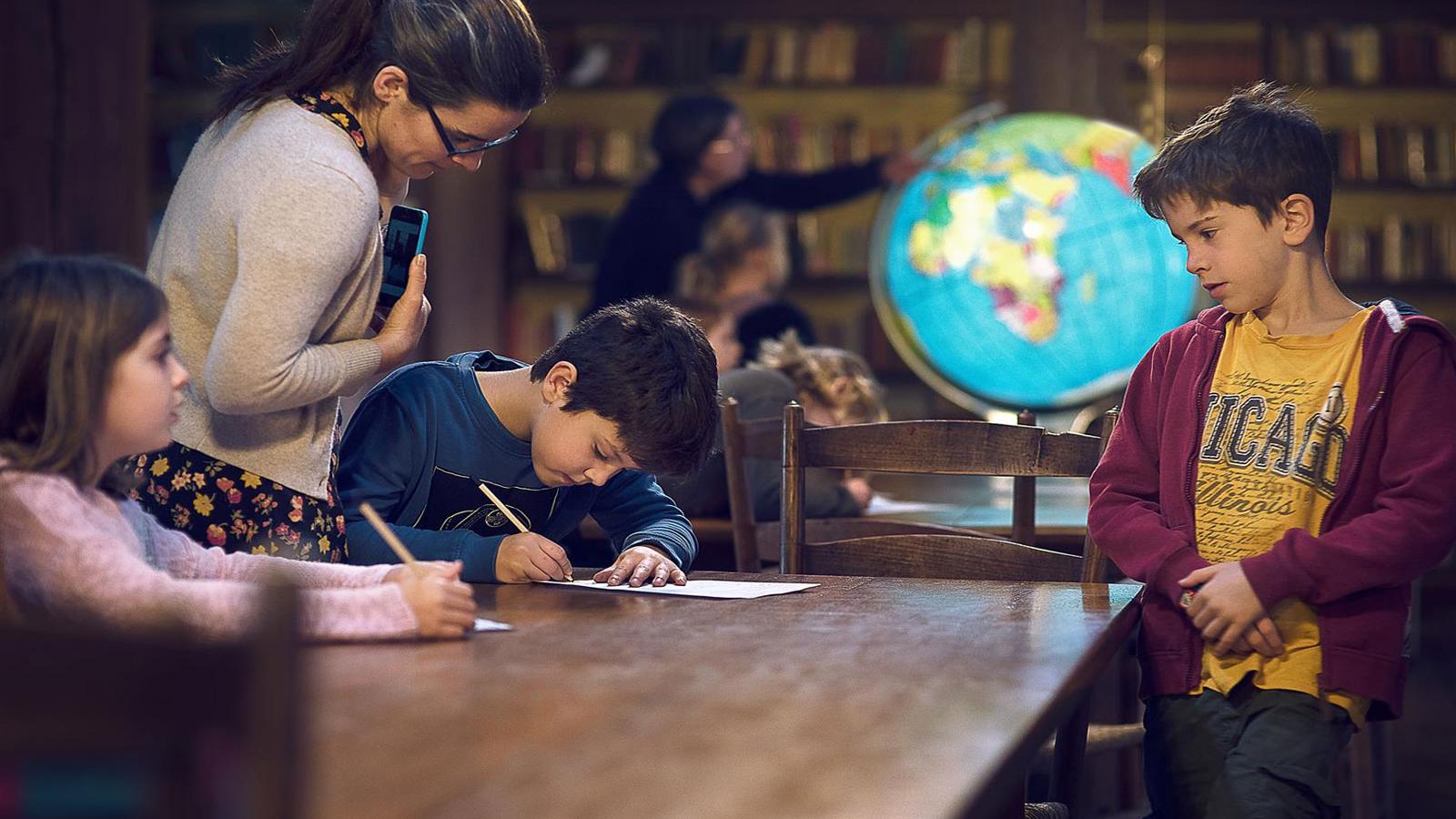
“I’m one of those chaotic people, who doesn’t organise my phone very well!” confessed Anna, as she scrolled through it, trying to find an image to show me of her own illustrations she had done of Pip, the protagonist from her bestselling debut novel, The Umbrella Mouse, that she wrote on her iPhone notepad during her daily commute on the London Underground. Unsuccessful in her search Anna gives up, “It was a huge relief in the end that we didn’t use my drawings because it would have been too much pressure with the other deadlines. I love the illustrations Sam Usher has produced, they are so good - and much more fitting for the story’s era.”
Anna was welcomed back to Bedales in October after a fellow OB shared the news with the school that The Umbrella Mouse had been selected for Waterstones’ Book of the Month. Since then, it’s won the Sainsbury’s Book Prize for Fiction and has been longlisted for another national award. Set in World War Two, the story was inspired by the real-life French Resistance network of spies called ‘Noah’s Ark’ and follows the perilous journey of a mouse trying to find a new home. Anna’s visit saw her working with 6:1 and Block 5 students, exploring structure, characterisation, rising action and resolution in their writing.
How does Anna’s writing technique compare to the formula she shares with students?
“For the first draft of The Umbrella Mouse, I didn’t use a plan at all. I think I grasped the fundamental shape of a story and what makes a good structure through osmosis. Generally, the secret to writing is reading as many books as you can, in the genre you want to write about. Every genre has its own conventions and I think it’s possible to pick them up if you read enough,” Anna explained as she spoke about her writing. “I didn’t read creative writing texts until I was editing later drafts of The Umbrella Mouse and I doubt it would have been published without that knowledge. That’s why I share what I’ve learnt with students. I remember feeling overwhelmed at the thought of writing a whole story that was good enough to be read by someone else, but it’s actually quite simple once you break it down.”
As a child of an artist and a ballet teacher, a creative career seems only fitting for Anna. As the third of four children, Anna’s childhood sounds like a lively and colourful affair, with creativity naturally playing a strong role in family life. “We grew up in a very creative environment; we all read a lot; my sister used to write plays, I was very arty, my brother was a drummer and my younger brother is an actor now. My parents loved Bedales. They both wanted to come here themselves so they thought it would be a good fit for us too.”
Had Anna considered following in her mother’s footsteps as a dancer? “I was a mischievous child and way too much of a tomboy to be a dancer - I was much more into climbing trees and was better at scraping my knees and getting twigs in my hair than pirouetting!”
Joining Bedales for the Sixth Form, Anna reflects on her schooling prior to Bedales as being much too stringent for her to have her creative ambitions embraced. “I felt liberated being at Bedales because I had come from a very strict secondary school in Suffolk, which wasn’t a happy experience for me. The other day, my brother and I were remembering how our time there felt more about survival than learning. This is really cheesy, but my other school seemed to be in monochrome, whereas Bedales was in colour; there was so much more encouragement and I definitely benefitted from being nurtured creatively and being treated as an individual.”
As a huge lover of books Anna enjoyed her time studying English at Bedales and fondly remembers the teachers that made the biggest impression on her: “Graham Banks really inspired me and I loved English. I had Alastair Langlands in 6:1. We did The Canterbury Tales and it was the most magical thing ever - he was brilliant! I wish I had done History at A Level because I loved it, but my teacher at my previous school hated me so I didn’t consider it as an option.”
Instead of History, Anna opted for Art and Drama A Levels alongside English, and it was the latter she wished to study at university. In the summer of 2002, Anna was devastated to have her English results caught amidst the OCR scandal in which headteachers accused the Government’s watchdog of forcing exam boards to mark down grades to counter claims the exam had become too easy. The A grade Anna had required to get into Bristol had been turned into a C. It was remarked to a B, dashing her confidence to study English, and instead took a highly coveted place at Goldsmiths, taking it as a sign to study Drama, in which she had been given an A, instead. “I’d always wanted to be either an author or an actress, but I soon realised after starting university I couldn’t cope with stage fright. You have to be so confident and ruthless and I never would have made it. I’m quite confident in some ways but also incredibly shy and introverted in others. In hindsight, I never should have accepted a place that someone else would have loved, but it confirmed I thrived offstage and I transferred to English.”
Before Anna started making a name for herself in the writing world she left university and embarked on an adventure with some friends across South East Asia and spent time teaching English in Thailand. “Unfortunately I had to return to the UK earlier than planned as my dad had a couple of heart attacks and my uncle had a major accident, so I wanted to be around for my family. I ended up working in Art PR for a while, which I really enjoyed, and that was also around the time I began drafting The Umbrella Mouse on the tube during my commute.”
Anna felt inspired to write The Umbrella Mouse after reading some astonishing statistics about how little adults and young people remembered about both World Wars and she wanted to write a new book that would teach children about WWII using animals:
“I love historical fiction and when I came across the French Resistance group that used animal code names, I knew I had to write an anthropomorphic story. Watership Down is one of my favourite books and it’s definitely influenced The Umbrella Mouse – as has War Horse and The Rescuers. My protagonist, Pip, came to me because I wanted the juxtaposition of a small animal confronting something huge, (such as war) and the smallest thing I could think of was a mouse. She became an umbrella mouse due to serendipity. I was on a train staring at the rain racing across the window and cursing myself for forgetting my umbrella when the two merged. London’s famous James Smith & Sons umbrella shop then popped into my head and a quick search online told me there was only one umbrella museum in the world. And that was that. My mouse’s life in London would be destroyed in a WWII bombing raid, forcing her on a quest to find a new home. The real-life French Resistance spies from Noah’s Ark would physically appear as their animal code-names and help her with other real-life animal war heroes.”
As with many creative successes, Anna had no initial plans for it to be anything significant except a form of escapism for herself.
“I was desperate to do something during my commute on the tube; it’s such a miserable place and I went through this awful phase of having terrible panic attacks on almost every journey. I managed to get over it by writing on my iPhone’s notepad and I soon became so immersed in it that I would even miss my stop. It was a long commute – over two hours a day – and sometimes I would even take the long way home if I didn’t have plans because I was enjoying The Umbrella Mouse so much. I wrote it for myself and I didn’t show it to anyone; I never thought a story about a mouse living inside an umbrella that joined the French Resistance would ever get published!”
Diagnosed with fibromyalgia in 2012, Anna relocated to Australia the following year and while struggling to find a job, she turned her attention to editing The Umbrella Mouse. Returning to the UK in late 2015, she became determined to publish the story she had been writing on/off for so long. “At 31, and really suffering from thirty-itis, I felt it was now or never. Luckily the one person I showed it to really believed in the book, and in me, and taught me how to submit it to an agent. Shortly after I was signed, I accepted a two-book deal from Macmillan and I was incredibly fortunate that Waterstones chose The Umbrella Mouse as their Book of the Month in June 2019 – a month after it was published. That push made it a top 10 bestseller in the children’s fiction chart and I’m eternally grateful.”
How has Anna found being a writer of a bestselling children’s book? “If you’d told my eighteen-year-old self where I am today, I wouldn’t have believed you, although I’d have been thrilled. It’s a fantastic job and I love it, but I’m still learning and it can be intense. A lot of children’s authors have to write more than one book a year, and that’s really tough because you are effectively writing more than two at once because you have to edit the first whilst writing the second etc., and it’s not easy - especially if you have to subsidise your income with other things. I’ve been really lucky to have had a bestseller for my first novel. I’m anxious the others to come won’t do as well, but I think that’s always going to be one of those things; you just have to keep trying and I’ll enjoy it for as long as it lasts.”

